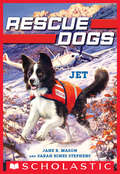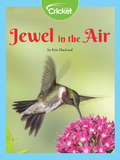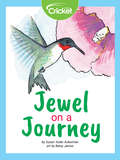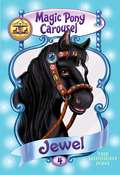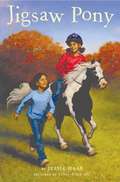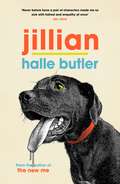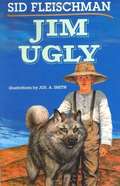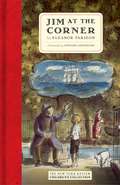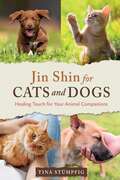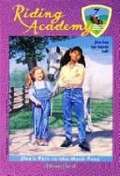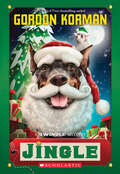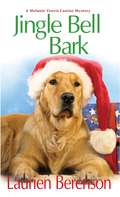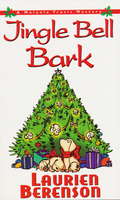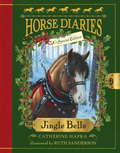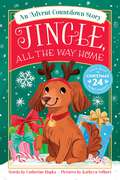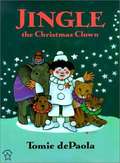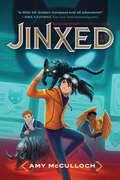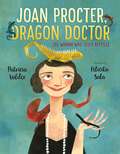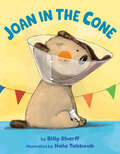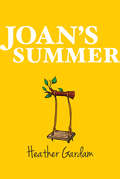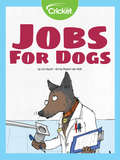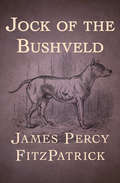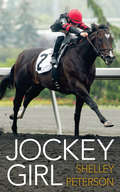- Table View
- List View
Jet (Rescue Dogs)
by Jane B. Mason Sarah Hines-StephensAction and adventure with high stakes and a happy ending -- and dogs!Jet is a border collie puppy tired of feeling hungry and lonely. He's tired of the collar that yanks at his neck and the leash that makes things worse. When his owners move away and leave him tied up in the backyard, it seems like Jet is running out of time.When Jet is saved by a home inspector, he's taken to the Sterling Center, where he shows all the classic signs of a great rescue dog, but he's terrified of the leash. When a plane goes down in the wilderness and a snowstorm is moving in, will Jet be able to overcome his fear in time to become a hero?
Jewel in the Air
by Kris MacLeodAlmost as light as a penny and with wings beating more than fifty times each second, these tiny Central American hummingbirds migrate 2,000 miles to reach their spring home. Readers will enjoy learning about the ruby-throated hummingbird along with a retelling of Mayan tale.
Jewel on a Journey
by Betsy James Susan Yoder AckermanTrey and Susannah hear a loud thump and learn that the fallen tiny bird laying on their deck is a Hummingbird! Miss Nora, their neighbor, cares for birds and may be able to help them save the bird. Discover what Miss Nora does to help the Hummingbird. Will the injured bird fly again?
Jewel the Midnight Pony (Magic Pony Carousel #4)
by Poppy Shire Ron BergThe Magic Pony Carousel is in town! Sophie is excited to ride Jewel, a jet black pony with a beautiful diamond-shaped white patch on his forehead. As soon as Sophie settles into Jewel's saddle, they are whisked back in time on a magical adventure. Together, Sophie and Jewel must capture a villain, return a stolen locket, and rescue their new friend, Lucy!
Jigsaw Pony
by Jessie Haas Ying-Hwa HuThe only thing twins Fran and Kiera have ever agreed on is that it would be wonderful to own a pony -- a pony they could gallop and leap over jumps.<P> One day their father brings them Jigsaw, a Shetland pony who needs a new family. Jigsaw is the perfect pony. He can do anything -- even fit himself into Dad's station wagon for the ride home.<P> But with Jigsaw comes trouble. The more Fran and Kiera like something, the harder it is for them to share. And they love Jigsaw. Worse, Jigsaw won't gallop far and he won't leap more than a couple of jumps. Is something wrong with the way the twins ride? Or is something wrong with Jigsaw?
Jillian: A Novel
by Halle ButlerFrom the author of the 'great' (Dolly Alderton), 'terrific' (Zadie Smith) The New Me, comes a subversive, hilarious portrait of two colleagues, each more like the other than they would care to admit.'Wretchedly riveting' Jia Tolentino, New Yorker'Butler is an essential contemporary voice' Literary Hub'A master of writing about work and its discontents' The MillionsMegan is only twenty-four but her life feels like a dead end. Working as a gastroenterologist's receptionist and resenting the success and happiness of her friends, the only thing that makes her feel better is obsessively critiquing the behaviour of her colleague, Jillian. A grotesquely optimistic thirty-five-year-old single mother, Jillian's chirpy positivity obscures her mounting struggles - until her downfall is precipitated by the purchase of a dog . . .'Outrageous and amusing ... reads like rubbernecking or a junk-food binge, compelling a horrified fascination and bleak laughter' Kirkus'The funniest book I've read in a long time, but also one of the most important ones' The Rumpus
Jim Ugly
by Sid FleischmanPart wolf, Jim Ugly is a proud and aloof one-man dog. And that man is Jake's father, an actor in the frontier West. Who suddenly disappears. Jake is left with his cousin who threatens to shoot Jim Ugly for killing sheep. Jake is sure the dog, who is an excellent tracker, is innocent and runs away hoping it will lead him to his father. He discovers that a bounty hunter and some actors are searching for his father, too, because they believe he has stolen a fortune in diamonds. For seventy-five cents a night and the sound of applause Jake plays the role of William Tell's son. Bravely standing tall while apples are shot from the top of his head. As Jake gets closer to finding his father he begins to make friends and to understand Jim Ugly. Maybe the smart, loyal dog deserves a better name. Sometimes funny, sometimes sad, this wild west mystery is exciting from start to finish.
Jim at the Corner
by Eleanor Farjeon Edward ArdizzoneThese seafaring tales begin on a street corner where Jim, a retired sailor, spends his days, passing the time telling a curious boy named Derry about life aboard his ship, the Rockinghorse. In the tradition of Robert Louis Stevenson’s A Child’s Garden of Verses and Rudyard Kipling’s Just So Stories, Farjeon’s tales of talking sea serpents and stew-eating chimpanzees bring the far near and turn ordinary weather into an astronomical adventure. With pen-and-ink illustrations by the maritime master artist Edward Ardizzone, Jim at the Corner is an old-fashioned adventure for the eyes and the ears.
Jimmy's Boa and the Big Splash Birthday Bash
by Trinka Hakes NobleJimmy's birthday party at Sealand turns into a big adventure.
Jin Shin for Cats and Dogs: Healing Touch for Your Animal Companions
by Tina Stümpfig• Includes body maps for both cats and dogs that clearly illustrate the positions of the Jin Shin Jyutsu energy points and explains how to work with them • Presents step-by-step illustrations and easy, brief explanations for point sequences for general health, first aid, and specific ailments, from ear mites and conjunctivitis to kidney infection, splinters, and anxiety • Provides sections with dog-specific and cat-specific ailments, organized by area of the body and symptoms, with recommended treatment points and sequences ARE YOU LOOKING FOR A GENTLE WAY to ease your cat&’s coughing or lighten the joint problems of your dog? Or maybe you want to relieve your pet&’s stress when going to the vet and help them recover after surgery? A soft touch method for harmonizing energy flow, Jin Shin Jyutsu is an excellent hands-on healing tool to support your animal companion&’s overall health and alleviate common ailments and injuries. By calmly placing your hands on certain energy points on your pet&’s body, you can release energetic blockages, strengthen the immune system, and stimulate their body&’s self-healing response. Easy step-by-step illustrations and body maps for both cats and dogs show how to use this simple system of two-point touch healing. From ear mites and conjunctivitis to kidney infection, splinters, and anxiety, just by holding certain points on the body of your cat or dog you can quickly relieve a symptom or trigger the start of a comprehensive healing process. Jin Shin Jyutsu not only improves their health and well-being but also offers an enjoyable moment of energetic exchange between you and your four-legged friend throughout all phases of life.
Jina's Pain-in-the-Neck Pony (Riding Academy #7)
by Alison HartJina deserves a blue ribbon for patience after her own horse is sidelined and she agrees to show a pony named Applejacks -- with a sour disposition -- and help out his seven-year-old owner, Whitney, who constantly demands attention.
Jingle (Swindle #8)
by Gordon KormanJINGLE: a light clinking or tingling sounds, often heralding the approach of Santa, reindeer, or the mysterious thief of a priceless possession . . . Griffin Bing and his friends are NOT happy. Instead of going away for winter break, they've been signed up to volunteer at a local Christmas extravaganza . . . as elves. It's not easy being an elf. Not when Santa is bad news and Rudolph is being played by a Doberman who makes up his own rules wherever he goes. But being an elf is nothing compared to being blamed when a prized Christmas possession -- worth over ten million dollars -- is stolen right from under your nose. It's time for these elves to get off the shelf and track down a Christmas thief!
Jingle Bell Bark (A Melanie Travis Canine Mystery #11)
by Laurien BerensonA sleuth rescues two orphaned Golden Retrievers—and tries to solve their master&’s murder—in this &“delightful&” mystery from the Agatha Award finalist (Publishers Weekly). This year, all Melanie wants for Christmas is a dull moment. Between her teaching job, and showing her Standard Poodle puppy, there just aren&’t enough hours in the day. But when her son Davey&’s usual bus driver, Henry Pruitt, disappears and is replaced by a surly, pierced twentysomething, Melanie is concerned. The elderly, amiable Henry was a friend to all in the neighborhood, so she decides to check on him…only to find that he died two days earlier, under suspicious circumstances. As if that weren&’t bad enough, Henry&’s two Golden Retrievers are now bereft of both master and home. Melanie can&’t just abandon them, so she brings them to her Aunt Peg, the most stubborn woman on the planet, who&’s now determined to find out the truth about Henry's death, no matter what it takes. Soon, the indomitable Aunt Peg has Melanie making a list of suspects and checking it twice. And unless she sniffs out this Scrooge of a killer fast, a lump of coal in her stocking may not be the worst thing Melanie gets this Christmas… &“As ever, the author provides a captivating behind-the-scenes look at the world of show dogs.&”—Publishers Weekly "Melanie Travis is a terrific character."--Romantic Times
Jingle Bell Bark (Melanie Travis Mysteries #11)
by Laurien BerensonBetween teaching, mothering, and prepping her Poodle for the next show, Melanie Travis barely has time to pencil in some Christmas festivities. Especially once she finds herself making a list of suspects--and checking it twice--when murder comes home for the holidays... This year, all Melanie wants for Christmas is a dull moment-but she's not going to get it. Between her eight-year-old son Davey, her teaching job, and showing her soon-to-be champion Standard Poodle puppy Eve, there just aren't enough hours in the day. Davey's in the Christmas play and the holidays are in full swing, so she'd like to make merry...or at least get around to decorating the tree! It would also be nice to spend a little time with her fiance, Sam. But when Davey's usual bus driver, Henry Pruitt, disappears and is replaced by a surly, pierced, gum-chewing twentysomething, Melanie is concerned. The elderly, amiable Henry was a friend to all in the neighborhood, so she decides to check on him...only to find that he died two days ago, under suspicious circumstances. As if that weren't bad enough, Henry's two Golden Retrievers, Pepper and Remington, are now bereft of both master and home. Naturally, Melanie can't just abandon them. So she brings them to her Aunt Peg, the most stubborn woman on the planet, who's now determined to find out the truth about Henry's death, no matter what it takes. It turns out that Henry wasn't always a bus driver-- before he retired, he had another career as a high-powered executive at an exclusive brokerage firm. He was also quite the ladies' man. Could one of his loves have turned lethal? Soon, the indomitable Aunt Peg is investigating.
Jingle Bells (Horse Diaries Special Edition)
by Catherine Hapka Ruth SandersonA heartwarming Clydesdale story for the holiday season! For all lovers of horses, history, and the holidays, here's a very special Horse Diaries book. Wisconsin, 1915. Jingle Bells is a strong Clydesdale gelding. He enjoys his work on the farm, pulling the hay wagon in the summer and a sleigh in the winter, and he loves his human friend, Kari. But when Kari's older brother comes home for Christmas with a new Model T Ford, will the family still need Jingle Bells?
Jingle, All the Way Home: An Advent Countdown Story
by Catherine HapkaAn Advent Novel: Count down to Christmas in twenty-four sealed chapters!They may live in Poinsettia, "the Most Christmassy Town in the U.S. of A.," but the Kerstman kids have never had a Christmas like this!When Chris discovers a puppy wedged in his family's chimney on Christmas morning, he knows exactly how it got there because the dog tells him. Jingle stowed away in Santa's sleigh, got left behind accidentally, and he can talk! Can Chris, his big sister, Holly, and her best friend, Ivy, find a way to help Jingle return to the North Pole?With full-color artwork and one sealed chapter to open each day, Jingle, All the Way Home is the perfect gift to bring festive cheer to your Christmas countdown!Catherine Hapka has published many books for children of all ages. As a kid she always wanted Santa to bring her a pony for Christmas. These days, she's lucky enough to live on a small farm in Chester County, Pennsylvania, with three oversize ponies (also know as horses) along with several rascally goats, a small flock of chickens, and too many cats.Kathryn Selbert is an award-winning freelance illustrator, author, and designer currently living in Montclair, New Jersey, with her tea-loving husband and grumpy French bulldog, Margot. She has so much Christmas spirit, she decorates her tree in November.
Jingle, the Christmas Clown
by Tomie DepaolaStaying behind when their circus moves on, a young clown and a troupe of baby animals put on a special Christmas Eve show for an Italian village too poor to celebrate the holiday. Includes a recipe for Donna Chiara's Stelline d'Oro cookies, created by Mary Ann Esposito, host of "Ciao Italia" the public television cooking program.
Jinxed (Jinxed #1)
by Amy McCullochThe Golden Compass meets the digital age! When a coding star enters an elite technology academy, she discovers a world of competition, intrigue, and family secrets—plus a robotic companion that isn't what it seems.Lacey Chu is a girl who codes. She has always dreamed of working as an engineer for MONCHA, the biggest tech firm in the world and the company behind the "baku"—a customizable "pet" with all the capabilities of a smartphone. But when Lacey is rejected by the elite academy that promises that future, she's crushed.One night, Lacey comes across the broken form of a highly advanced baku. After she repairs it, the cat-shaped baku she calls Jinx opens its eyes and somehow gets her into her dream school. But Jinx is different than any other baku she's ever seen…He seems real.As Lacey settles into life at school, competing with the best students in a battle of the bakus that tests her abilities, she learns that Jinx is part of a dangerous secret. Can Lacey hold on to Jinx and her dreams for the future?Jinxed is the perfect…middle grade book for girls who are passionate about codingsummer reading chapter book for kids 9-12science fiction book for kids 9-12engineer academy bookrobot book for kids"With a sharp eye toward the rising awareness of device addiction and a keen sense of wonder, McCulloch's tale is a feast for the imagination that celebrates women in STEM fields."—Publisher's Weekly, STARRED review"I raced through this book…a little bit Golden Compass and all adventure."—Amie Kaufman, New York Times bestselling author
Joan Procter, Dragon Doctor: The Woman Who Loved Reptiles
by Patricia ValdezFor fans of Ada Twist: Scientist comes a fascinating picture book biography of a pioneering female scientist--who loved reptiles!Back in the days of long skirts and afternoon teas, young Joan Procter entertained the most unusual party guests: slithery and scaly ones, who turned over teacups and crawled past the crumpets.... While other girls played with dolls, Joan preferred the company of reptiles. She carried her favorite lizard with her everywhere--she even brought a crocodile to school!When Joan grew older, she became the Curator of Reptiles at the British Museum. She went on to design the Reptile House at the London Zoo, including a home for the rumored-to-be-vicious komodo dragons. There, just like when she was a little girl, Joan hosted children's tea parties--with her komodo dragon as the guest of honor.With a lively text and vibrant illustrations, scientist and writer Patricia Valdez and illustrator Felicita Sala bring to life Joan Procter's inspiring story of passion and determination.A Chicago Public Library Best Book of the Year selection
Joan in the Cone
by Billy SharffFor fans of Grumpy Monkey and The Pout-Pout Fish comes the heroic tale of one dog's journey to cope with life's inconveniences and all its . . . accessoriesJoan&’s life is wonderful, wild, and grand—running and playing as much as she can!Days full of fun, where she&’s never alone.And then . . . came . . . the cone.For Joan the dog, life is different now. With her cone, she gets trapped in the doggy door. And she doesn't command the same respect she once did at the dog park. Through funny challenges and mortifications, Joan reflects on her pre-cone glory days, including what led to her injury (let's just say, certain choices were made). But with time, Joan begins to see there is love and life and joy beyond the rim of the cone—and sometimes popcorn inside it too, because, it turns out, the cone makes a great snack bowl.This picture book is guaranteed to make kids and caregivers laugh, and see the trials of life—and dogs in cones—in a whole new way.&“Perfect for fans of Doug Salati's Hot Dog.&” —Booklist&“Dynamic, expressive, and funny.&” —Kirkus&“A perfect read-aloud for children, especially [to teach] resilience and acceptance.&” —SLJ
Joan's Summer
by Heather Gardam"Maybe, if she worked really hard, Patti thought, maybe if she just had a chance to be alone for a while, she would feel better. Get her life back to where it used to be before... But... but that was a kind of running away, too, wasn't it? How much running could a person do? Surely you had to just get on with a problem sometime!" In this third book of the Patti Stories, Patti, who is twelve now, is faced with a difficult problem in the person of her friend Joan. This isn't the first time she has found Joan perplexing, annoying, and just plain unacceptable, but this time the Joan dilemma has moved much too close - into Patti's bedroom, to be exact!
Jobs for Dogs
by Liz HuyckDogs have many abilities, along with being super cute–they have great noses that can sniff out smells that humans can’t! Canines are known for their sense of smell, from sniffing luggage in the airport to find illegal items, or having the ability to detect illness, or rescue people, canines are man’s best friend! Discover all the skilled jobs that man’s best friend can do that help people.
Jock of the Bushveld
by James Percy FitzpatrickThe touching true story of an indefatigably loyal dog While James Percy FitzPatrick was working as a transport rider in South Africa, 1 of his companion dogs--a well-bred Staffordshire Bull Terrier--had a litter of 6 puppies. All of the newborn terriers were perfect, healthy specimens--except for the runt, "a poor, miserable little rat of a thing about half the size of the others." This sickly pup caught FitzPatrick's attention and unexpectedly grew up to become a paragon of loyalty and bravery, serving as the author's canine companion for many years to come. Jock of the Bushveld is a must-read for any dog lover. This ebook has been professionally proofread to ensure accuracy and readability on all devices.
Jockey Girl
by Shelley PetersonCCBC’s Best Books for Kids & Teens (Fall 2016) — Commended 2016 VOYA Top Shelf Fiction Selection A teen girl’s quest to find her mother leads her to the big city, and gives her the courage to fulfill her dream of becoming a jockey. Evangeline “Evie” Gibb lives a seemingly charmed life on a thoroughbred racehorse farm. But in reality, Evie feels alone in the world, cheered only by the affection of a racehorse named No Justice. She’s always been told that her mother, Angela Parson, is dead. Then, on her sixteenth birthday, a card arrives from her great aunt Mary with the suggestion that Angela might still be alive — and Evie’s life is turned upside down. In hopes of winning enough money to leave her hateful father and find her mother, Evie enters the Caledon Horse Race. But something she overhears her father say changes everything, and Evie steals the racehorse in the night and runs away. With a stray dog named Magpie at her side and help from Aunt Mary, Evie unearths long-hidden family secrets, finds unexpected love, and takes the racing world by storm.
